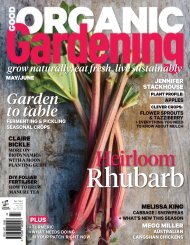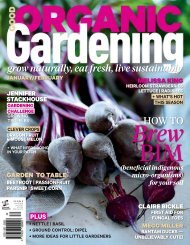5. Good Organic Gardening - September-October 2016 AvxHome.in
5. Good Organic Gardening - September-October 2016 AvxHome.in
5. Good Organic Gardening - September-October 2016 AvxHome.in
You also want an ePaper? Increase the reach of your titles
YUMPU automatically turns print PDFs into web optimized ePapers that Google loves.
PEST PATROL | Beneficial <strong>in</strong>sects<br />
Other major<br />
players<br />
Here are some of the ma<strong>in</strong> beneficial<br />
<strong>in</strong>sect species, but there are probably<br />
hundreds of other good guys at work<br />
<strong>in</strong> your garden right now.<br />
• Bees<br />
• Spiders<br />
• Wasps<br />
• Damsel flies<br />
• Predatory beetles<br />
• Dragonflies<br />
• Butterflies<br />
• Assass<strong>in</strong> bugs<br />
Even flies and ants have important<br />
roles to play, believe it or not.<br />
Lacew<strong>in</strong>g eggs<br />
Attract<strong>in</strong>g the<br />
good guys<br />
Most <strong>in</strong>sects have various stages<br />
with<strong>in</strong> their lifecycles with vary<strong>in</strong>g food<br />
preferences; even then, a lot of adults like to<br />
have variety <strong>in</strong> their diets.<br />
This can be <strong>in</strong> the form of nectar and pollen<br />
as well as all those bad bugs they munch on.<br />
Grow<strong>in</strong>g a varied range of flower<strong>in</strong>g plants<br />
and provid<strong>in</strong>g habitat for them to live and rest<br />
<strong>in</strong> is the first step.<br />
I have always called myself an eclectic<br />
gardener. I like natives next to cottage<br />
perennials and succulents — especially the<br />
flower<strong>in</strong>g aloes dotted all over the place —<br />
along with edibles, all mixed <strong>in</strong> with flower<strong>in</strong>g<br />
annuals. It turns out that this accidental<br />
biodiversity I have is perfect for encourag<strong>in</strong>g<br />
beneficial <strong>in</strong>sects.<br />
Lacew<strong>in</strong>g<br />
Australian hoverfly<br />
Simosyrphus grandicornis<br />
Step 1: What to grow<br />
Annual flower<strong>in</strong>g plants: Alyssum, cosmos,<br />
l<strong>in</strong>aria, sunflowers, z<strong>in</strong>nias, nasturtiums,<br />
Queens Anne’s lace, marigolds, calendulas,<br />
poppies, heliotrope<br />
Perennials and shrubs: Daisies, buddleias,<br />
salvias, flower<strong>in</strong>g aloes and a good range<br />
of natives such as callistemons, grevilleas,<br />
melaleucas and more will br<strong>in</strong>g not only the<br />
good bugs but larger predators like birds and<br />
small animals.<br />
Herbs: Parsley, yarrow, dill, fennel, basil,<br />
thyme, coriander, tansy, lavender, rocket,<br />
mustard, chives, rosemary, thyme. You could<br />
actually have some “sacrificial herbs”, such as<br />
tansy, fennel and dill, which will attract aphids<br />
and so give ladybirds someth<strong>in</strong>g to eat.<br />
With most of these plant species it’s the<br />
flowers that do all the attract<strong>in</strong>g. But they<br />
will also work for you <strong>in</strong> many other positive<br />
ways <strong>in</strong> the garden. If scented, they will<br />
distract and confuse the bad bugs, as will a<br />
Phytoseiulus persimilis<br />
We should actually be grateful for the<br />
so-called bad bugs, as they are more often<br />
than not an important sign that someth<strong>in</strong>g<br />
is amiss <strong>in</strong> the garden. Kill<strong>in</strong>g them all off<br />
can be a little like shoot<strong>in</strong>g the messenger.<br />
garden with a variety of shapes and sizes of<br />
plants and flowers. They will help disguise<br />
your prized edibles if <strong>in</strong>terplanted among<br />
them and attract a great array of poll<strong>in</strong>ators.<br />
Step 2: Habitat<br />
Plants are not the only key to attract<strong>in</strong>g<br />
beneficials. It’s important to create habitat<br />
with<strong>in</strong> your garden — for example, by<br />
leav<strong>in</strong>g leaf litter alone. Mimick<strong>in</strong>g nature is<br />
what it’s all about.<br />
Logs and stones make great hidey-holes<br />
for t<strong>in</strong>y creatures. Mulch can be a lot like<br />
leaf litter, provid<strong>in</strong>g shelter and habitat.<br />
Ponds, water features and even bog gardens<br />
will attract a great range of good bugs and<br />
even larger garden <strong>in</strong>sect predators such as<br />
frogs and lizards.<br />
Mick Talbot CC, Graham Wise CC<br />
60 | <strong>Good</strong> <strong>Organic</strong> <strong>Garden<strong>in</strong>g</strong>

















